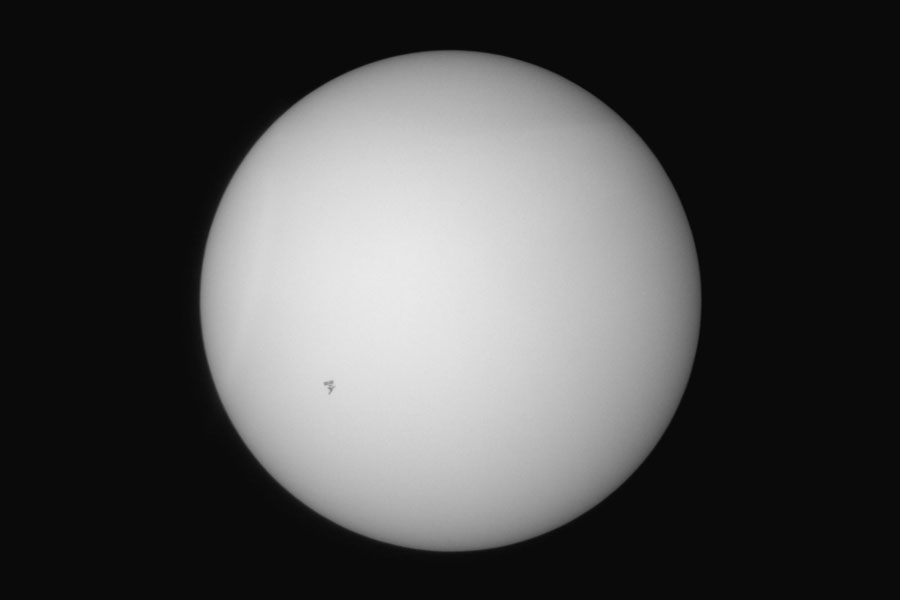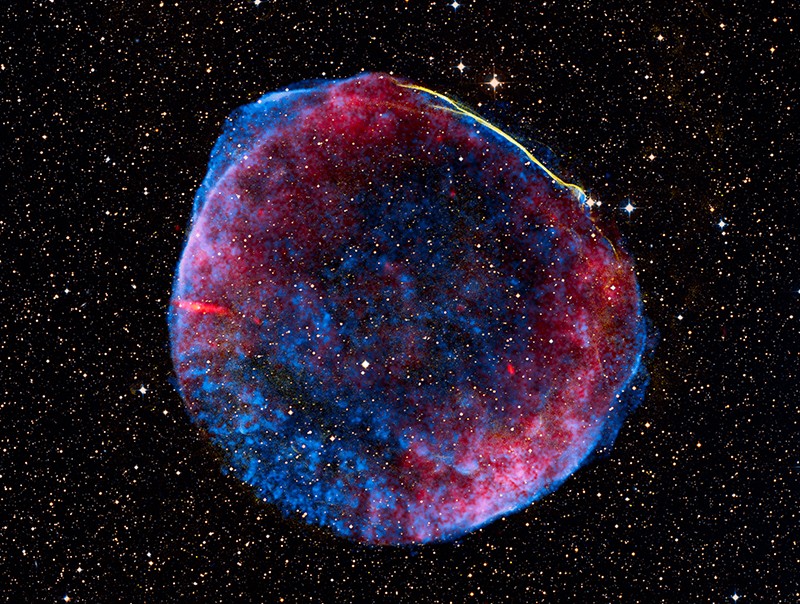Astronomy Picture of the Day
It' more like the Astronomy picture of the month. ![]()

The International Space Station Transits the Sun
Credit & Copyright: Martin Wagner
Explanation: That's no sunspot. It's the International Space Station (ISS) caught by chance passing in front of the Sun. Sunspots, individually, have a dark central umbra, a lighter surrounding penumbra, and no solar panels. By contrast, the ISS is a complex and multi-spired mechanism, one of the largest and most sophisticated machines ever created by humanity. Also, sunspots occur on the Sun, whereas the ISS orbits the Earth. Transiting the Sun is not very unusual for the ISS, which orbits the Earth about every 90 minutes, but getting one's timing and equipment just right for a great image is rare. Strangely, besides that fake spot, the Sun, last week, lacked any real sunspots. Sunspots have been rare on the Sun since the dawn of the current Solar Minimum, a period of low solar activity. Although fewer sunspots have been recorded during this Solar Minimum than for many previous decades, the low solar activity is not, as yet, very unusual.
_________________
Be kinder than necessary for everyone is fighting some kind of battle
-Jaleb
Whenever you see a close up of a galaxy, like that, it always awes me to think that almost
every other piece of light you can see is another galaxy, even further out!
Did you notice the 'little' double in the bottom left corner, just above "Team"?
cute! Any serious amateurs know what they are called / find a pic?
Aother Nebula:

SN 1006 Supernova Remnant
Credit: X-ray - NASA/CXC/Rutgers/G.Cassam-Chenai, J.Hughes et al.; Radio - NRAO/AUI/NSF/GBT/VLA/
Dyer, Maddalena & Cornwell; Optical - Middlebury College/F.Winkler, NOAO/AURA/NSF/CTIO Schmidt & DSS
Explanation: A new star, likely the brightest supernova in recorded human history, lit up planet Earth's sky in the year 1006 AD. The expanding debris cloud from the stellar explosion, found in the southerly constellation of Lupus, still puts on a cosmic light show across the electromagnetic spectrum. In fact, this composite view includes X-ray data in blue from the Chandra Observatory, optical data in yellowish hues, and radio image data in red. Now known as the SN 1006 supernova remnant, the debris cloud appears to be about 60 light-years across and is understood to represent the remains of a white dwarf star. Part of a binary star system, the compact white dwarf gradually captured material from its companion star. The buildup in mass finally triggered a thermonuclear explosion that destroyed the dwarf star. Because the distance to the supernova remnant is about 7,000 light-years, that explosion actually happened 7,000 years before the light reached Earth in 1006. Shockwaves in the remnant accelerate particles to extreme energies and are thought to be a source of the mysterious cosmic rays.
Yowza!
Colliding galaxies are a classic. May favs are the Antenna Galaxy

For the astronomy geeks out there, I discovered a nifty free program called "Celestia" which has a pretty good 3d map of select parts of the universe. Like Google Earth only without the internet and for the stars/solar system. Homepage here
_________________
* here for the nachos.

This is of course not a real picture, but a representation of the distribution of matter in the universe at very large scales. It gives the density of dark matter, but this in structure seems similar enough to the normal matter distribution they give.
source http://www.mpa-garching.mpg.de/galform/millennium/
_________________
* here for the nachos.
^ It reminds me of... neurons in a human brain!
*Hums spooky music to self*
If anyone can't see the picture, try posting a reply, then it should show up.
At least, it did for me, or, maybe it's just me? ![]()
And now for something completely different.


Check out this site for some cool space art and to see the last image full size:
http://www.worth1000.com/cache/gallery/ ... =photoshop







